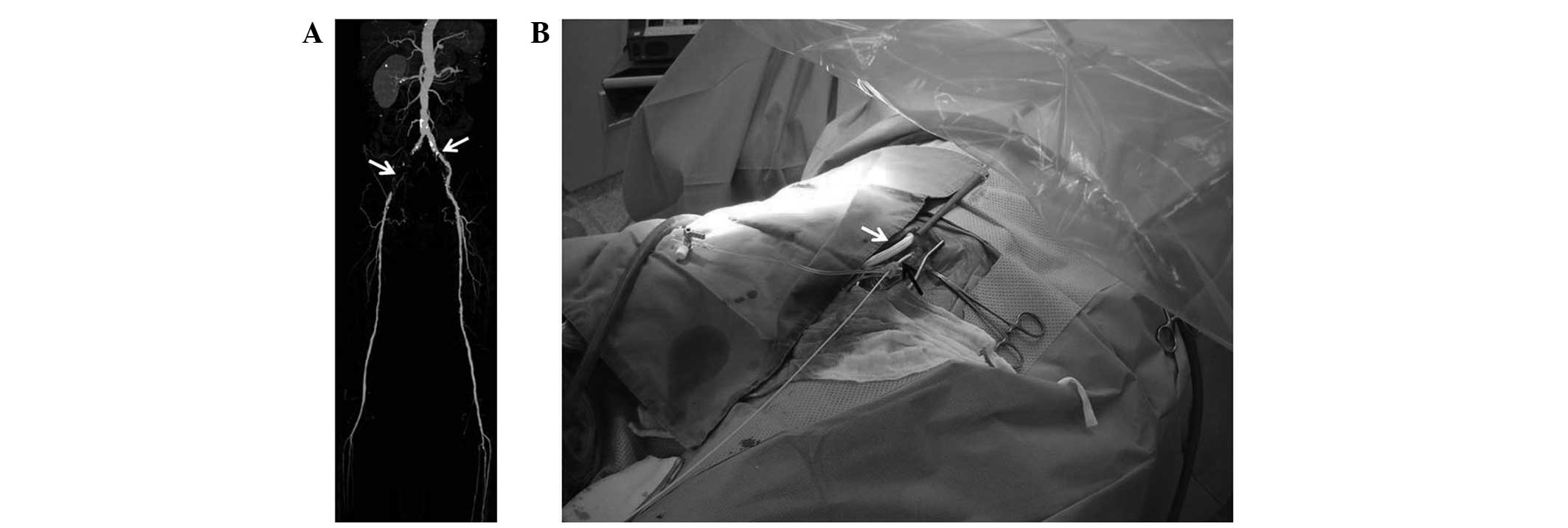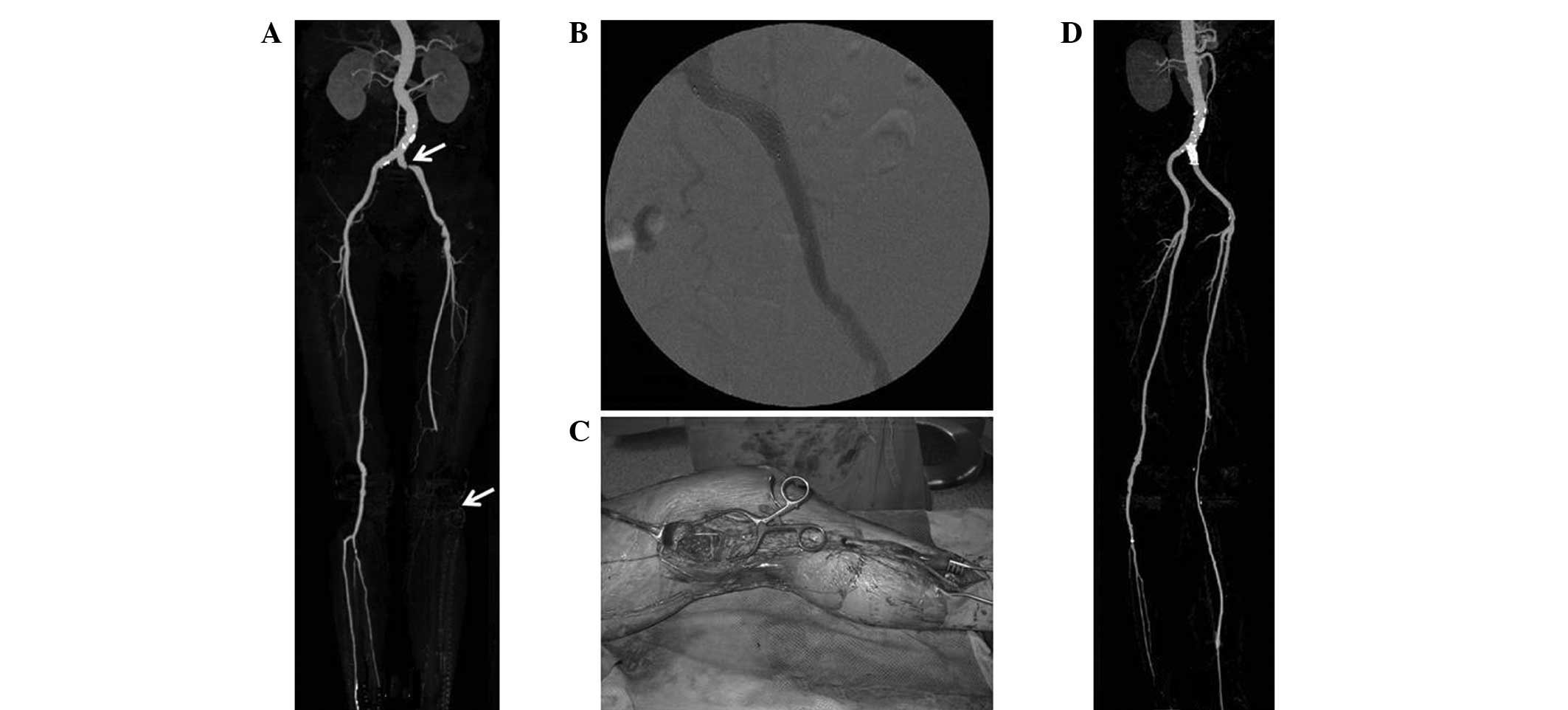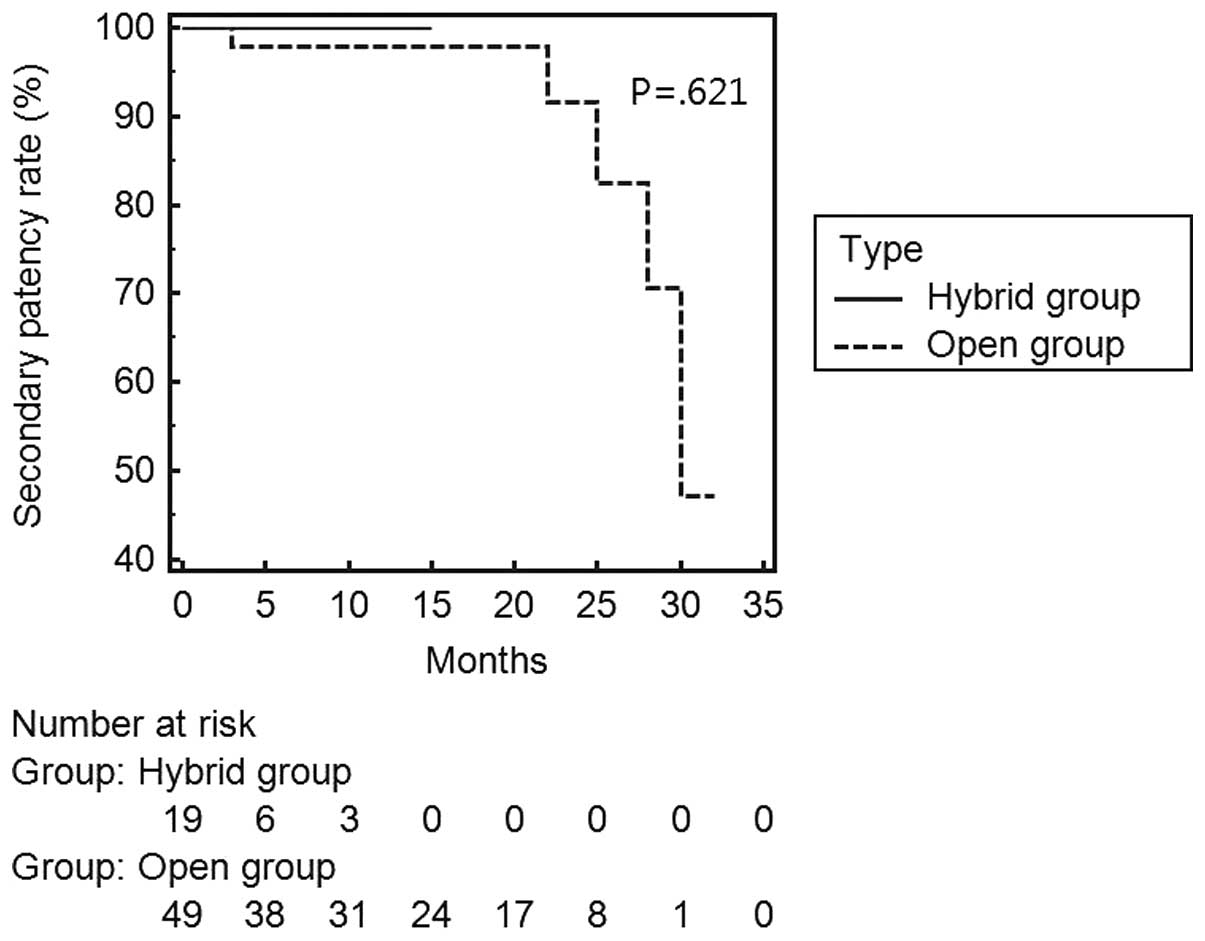|
1
|
Norgren L, Hiatt WR, Dormandy JA, et al:
Inter-society consensus for the management of peripheral arterial
disease (TASC II). J Vasc Surg. 45(Suppl S): S5–S67. 2007.
View Article : Google Scholar
|
|
2
|
Wilson SE, White GH, Wolf G and Cross AP:
Proximal percutaneous balloon angioplasty and distal bypass for
multilevel arterial occlusion. Veterans administration cooperative
study no 199. Ann Vasc Surg. 4:351–355. 1990. View Article : Google Scholar
|
|
3
|
Brewster DC, Cambria RP, Darling RC, et
al: Long-term results of combined iliac balloon angioplasty and
distal surgical revascularization. Ann Surg. 210:324–331. 1989.
View Article : Google Scholar : PubMed/NCBI
|
|
4
|
Queral LA, Criado FJ and Patten P:
Retrograde iliofemoral endarterectomy facilitated by balloon
angioplasty. J Vasc Surg. 22:742–748. 1995. View Article : Google Scholar : PubMed/NCBI
|
|
5
|
Nelson PR, Powell RJ, Schermerhorn ML, et
al: Early results of external iliac artery stenting combined with
common femoral artery endarterectomy. J Vasc Surg. 35:1107–1113.
2002. View Article : Google Scholar : PubMed/NCBI
|
|
6
|
Timaran CH, Prault TL, Stevens SL, et al:
Iliac artery stenting versus surgical reconstruction for TASC
(TransAtlantic Inter-Society Consensus) type B and type C iliac
lesions. J Vasc Surg. 38:272–278. 2003. View Article : Google Scholar : PubMed/NCBI
|
|
7
|
Schanzer A, Owens CD, Conte MS and Belkin
M: Superficial femoral artery percutaneous intervention is an
effective strategy to optimize inflow for distal origin bypass
grafts. J Vasc Surg. 45:740–743. 2007. View Article : Google Scholar : PubMed/NCBI
|
|
8
|
Schneider PA: Iliac angioplasty and
stenting in association with infrainguinal bypasses: timing and
techniques. Semin Vasc Surg. 16:291–299. 2003. View Article : Google Scholar : PubMed/NCBI
|
|
9
|
Dosluoglu HH and Cherr GS: Pre-arteriotomy
guidewire access (PAGA): a crucial maneuver for securing inflow
and/or outflow in patients with bulky iliofemoral occlusive disease
undergoing combined (open/endovascular) procedures. Eur J Vasc
Endovasc Surg. 32:97–100. 2006. View Article : Google Scholar
|
|
10
|
Galaria II, Surowiec SM, Tanski WJ, et al:
Popliteal-to-distal bypass: identifying risk factors associated
with limb loss and graft failure. Vasc Endovasc Surg. 39:393–400.
2005. View Article : Google Scholar : PubMed/NCBI
|
|
11
|
Grego F, Antonello M, Stramana R, et al:
Popliteal-to-distal bypass for limb salvage. Ann Vasc Surg.
18:321–328. 2004. View Article : Google Scholar : PubMed/NCBI
|
|
12
|
Schneider PA, Caps MT, Ogawa DY and Hayman
ES: Intraoperative superficial femoral artery balloon angioplasty
and popliteal to distal bypass graft: an option for combined open
and endovascular treatment of diabetic gangrene. J Vasc Surg.
33:955–962. 2001. View Article : Google Scholar
|
|
13
|
Cotroneo AR, Iezzi R, Marano G, et al:
Hybrid therapy in patients with complex peripheral multifocal
steno-obstructive vascular disease: two-year results. Cardiovasc
Intervent Radiol. 30:355–361. 2007.PubMed/NCBI
|
|
14
|
Dosluoglu HH, Lall P, Cherr GS, et al:
Role of simple and complex hybrid revascularization procedures for
symptomatic lower extremity occlusive disease. J Vasc Surg.
51:1425–1435. 2010. View Article : Google Scholar : PubMed/NCBI
|
|
15
|
Aho PS and Venermo M: Hybrid procedures as
a novel technique in the treatment of critical limb ischemia. Scand
J Surg. 101:107–113. 2012. View Article : Google Scholar : PubMed/NCBI
|
|
16
|
Matthews MA, Satiani B and Lohr JM: Trends
in a changing vascular practice environment for members of the
Society for Vascular Surgery. J Vasc Surg. 57:586–592. 2013.
View Article : Google Scholar : PubMed/NCBI
|
|
17
|
Tedesco MM, Pak JJ, Harris EJ Jr, et al:
Simulation-based endovascular skills assessment: the future of
credentialing? J Vasc Surg. 47:1008–1014. 2008. View Article : Google Scholar : PubMed/NCBI
|
|
18
|
Lee JT, Qiu M, Teshome M, et al: The
utility of endovascular simulation to improve technical performance
and stimulate continued interest of preclinical medical students in
vascular surgery. J Surg Educ. 66:367–373. 2009. View Article : Google Scholar : PubMed/NCBI
|
|
19
|
Aparajita R, Zayed MA, Casey K, et al:
Development and implementation of an introductory endovascular
training course for medical students. Ann Vasc Surg. 25:1104–1112.
2011. View Article : Google Scholar : PubMed/NCBI
|
|
20
|
Markovic J, Peyser C, Cavoores T, et al:
Impact of endovascular simulator training on vascular surgery as a
career choice in medical students. J Vasc Surg. 55:1515–1521. 2012.
View Article : Google Scholar : PubMed/NCBI
|
|
21
|
Ebaugh JL, Gagnon D, Owens CD, et al:
Comparison of costs of staged versus simultaneous lower extremity
arterial hybrid procedures. Am J Surg. 196:634–640. 2008.
View Article : Google Scholar : PubMed/NCBI
|















